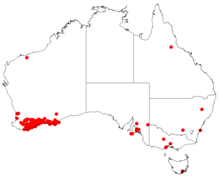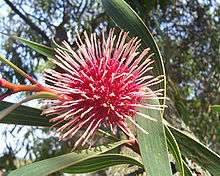Hakea laurina
Hakea laurina is shrub or small tree commonly known as kodjet or pin-cushion hakea[2] and is endemic to Western Australia. The Noongar name for the plant is kodjet or kojet.[3] It has red and cream conspicuous globular flowers and lance shaped leaves.
| Hakea laurina | |
|---|---|
 | |
| Hakea laurina inflorescences at different stages of maturity | |
| Scientific classification | |
| Kingdom: | Plantae |
| Clade: | Tracheophytes |
| Clade: | Angiosperms |
| Clade: | Eudicots |
| Order: | Proteales |
| Family: | Proteaceae |
| Genus: | Hakea |
| Species: | H. laurina |
| Binomial name | |
| Hakea laurina | |
 | |
| Occurrence data from AVH | |

Description
Hakea laurina is an upright shrub or small tree with smooth grey bark, 2.5–6.0 m (8 ft 2 in–19 ft 8 in) high, 3–5 m (9.8–16.4 ft) wide and does not form a lignotuber. The inflorescence consists of 120-190 conspicuous white, deep pink or red pin cushion shaped flowers in the leaf axils. The pedicels are 5.5–9.5 mm (0.22–0.37 in) long and smooth. The perianth is dark pink to red, the pistil 14–19.5 mm (0.55–0.77 in) long, cream-white or occasionally red or dark pink. The flower buds are enclosed in scale-like bracts. Flowering occurs from April to July. The leaves are simple, slightly blue green, flat, smooth, margins entire, lance or egg-shaped and taper to a blunt point at the tip. The leaves are arranged alternately along the branches, 7–21 cm (2.8–8.3 in) long, 6–29 mm (0.24–1.14 in) wide on a stem 1–2 cm (0.39–0.79 in) long and narrowing at the base. The fruit are in clusters of 1-10 per axil, 2.2–3.8 cm (0.87–1.50 in) long, 1.6–2.3 cm (0.63–0.91 in) wide, egg-shaped, smooth, occasionally with rough pitting and ending in a short beak.[2][4][5]
Taxonomy and naming
Hakea laurina was first formally described 1830 by Robert Brown and the description was published in Supplementum primum prodromi florae Novae Hollandiae.[6][7] The specific epithet is derived from the Latin laurus with reference to the resemblance of the leaves to laurel.[4]
Distribution
Pincushion hakea occurs in the sandplains of the coastal southwest of Australia, the northernmost range being Narrogin and extending east to Esperance. The habitat is often sandplains, sometimes occurring on sandy clay; most recorded specimens are in the southern districts of its botanical province.
Cultivation
The plant, which is propagated from seeds, is used in cultivation in the eastern states of Australia, and as a hedging or street plant in America and Italy.[4] Adaptable to a number of soil types, the plant is also tolerant of frost. The uses of this species include ornament and shading in public streets, wildlife habitat, windbreaks, and control of soil erosion.
In the language of flowers, Hakea laurina symbolises nobility and longevity.
References
- "Hakea laurina". Australian Plant Census. Retrieved 25 December 2019.
- Young, Jennifer (2006). Hakeas of Western Australia-A Field and Identification Guide. J.A Young. ISBN 0-9585778-2-X.
- "Noongar names for plants". kippleonline.net. Archived from the original on 20 November 2016. Retrieved 7 December 2016.
- "Hakea laurina". Growing Native Plants. Australian National Botanic Gardens (ANBG). 11 October 2006. Retrieved 2008-02-28.
- "Hakea laurina". Fact Sheet-Flora of South Australia. Retrieved 26 December 2019.
- "Supplementum primum prodromi florae Novae Hollandiae". Biodiversity Heritage Library. Retrieved 26 December 2019.
- "Hakea laurina". Australian Plant Name Index. Retrieved 26 December 2019.
External links
![]()
![]()
| Taxon identifiers |
|
|---|